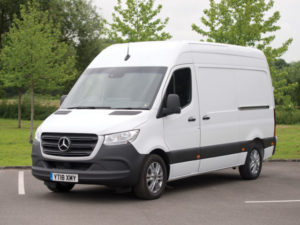With the third-generation Sprinter, the focus is on technology and connectivity, says Dan Gilkes.
Sector Large van Load volume 7.8m3-17m3 Power 114-177bhp Gross weight 3.0-5.5 tonnes CO2 178-253g/km

Mercedes’ Sprinter van holds an enviable position in the UK large van market, attracting a big share of the home delivery and courier business, a major slice of the supermarket delivery sector and with a solid grip on the blue light arena among others. Changes to what has been a very successful formula have, therefore, to be well thought out and to bring a noticeable benefit to the customer.
While the van’s external appearance is not going to make many waves among buyers, some of the technology on offer beneath the skin of the latest Sprinter may take a bit more time to catch on.
“Customers need to be asking not, what is it going to cost me, but what is it going to save,” says Mercedes-Benz Vans managing director Steve Bridge.
“The automotive industry will change more in the next five years, than it has in the last 50 and we are shifting from being a vehicle manufacturer, to providing a holistic transport and mobility solution.”
Sprinter is going to be at the heart of this change, though it too will have to move from being simply a piece of hardware, to providing a combination of hardware and software solutions. In turn, Mercedes-Benz Vans is planning to become an integral component in the way its customers run their businesses, providing far more than just the van.
At the centre of this change is connectivity and all new Sprinters will have a high-speed internet facility built in. Mercedes will use this to offer up to 18 PRO Connect packages, though only eight will be available initially. However, the unit will go on to allow customers to add functionality, both from Mercedes and from third-party suppliers, making it possible to use the system with existing and future fleet management and telematics systems.
The eight Mercedes packages available from day one include vehicle supervision, fleet communication, maintenance management, accident management and a digital driver’s log. All of these systems will make full use of the new MBUX multimedia system, which comes as standard in the UK with a seven-inch colour touchscreen, but is also offered with an incredible 10.25-inch high-definition touchscreen as an option. Satellite navigation is available on both, though Mercedes warns that it can only be specified from the factory; there will be no option to retro-fit satnav at a later date.
MBUX makes big use of voice control, with the driver starting any command with the opener “Hey Mercedes….” The system asks what is required, offering navigation, mobile communications, local information such as restaurants or fuel station locations and can even adjust functionality within the van. During our test drive the Traffic Alert function kept cutting in, though the radio volume was muted. We simply asked Mercedes to turn off Traffic Alert and it happened.
You get the feeling that we are just scratching the surface at present, yet already it is impressive stuff. Van operators are having to rapidly change to meet the needs of an increasingly on-demand, online market. The new Sprinter shows that van manufacturers must do the same.
What we think
The availability of front as well as rear-wheel drive may have grabbed the initial headlines, but the big impact of this third-generation Sprinter will be technology-based.

